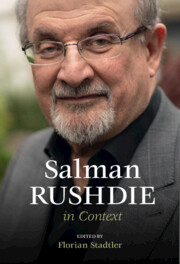Book contents
- Salman Rushdie in Context
- Salman Rushdie in Context
- Copyright page
- Dedication
- Contents
- Contributors
- Acknowledgements
- Introduction
- Part I Life
- Part II Literary and Creative Contexts
- Chapter 5 Salman Rushdie and the Urdu Tradition
- Chapter 6 Art-Historical Magic Realism and Rushdie’s Twenty-First-Century Politics
- Chapter 7 Salman Rushdie and Intertextuality
- Chapter 8 Salman Rushdie and Visual Art and Culture
- Chapter 9 Rushdie, Sound, and the Auditory Imagination
- Part III Historical and Cultural Contexts
- Part IV Critical Theoretical Contexts
- Part V Reception, Criticism, and Adaptation
- Works by Salman Rushdie
- Select Bibliography
- Index
Chapter 8 - Salman Rushdie and Visual Art and Culture
from Part II - Literary and Creative Contexts
Published online by Cambridge University Press: 23 March 2023
- Salman Rushdie in Context
- Salman Rushdie in Context
- Copyright page
- Dedication
- Contents
- Contributors
- Acknowledgements
- Introduction
- Part I Life
- Part II Literary and Creative Contexts
- Chapter 5 Salman Rushdie and the Urdu Tradition
- Chapter 6 Art-Historical Magic Realism and Rushdie’s Twenty-First-Century Politics
- Chapter 7 Salman Rushdie and Intertextuality
- Chapter 8 Salman Rushdie and Visual Art and Culture
- Chapter 9 Rushdie, Sound, and the Auditory Imagination
- Part III Historical and Cultural Contexts
- Part IV Critical Theoretical Contexts
- Part V Reception, Criticism, and Adaptation
- Works by Salman Rushdie
- Select Bibliography
- Index
Summary
In The Moor’s Last Sigh, Vasco Miranda describes the artist Aurora da Gama Zogoiby’s work as ‘“Epico-Mythico-Tragico-Comico-Super-Sexy-High-Masala-Art” in which the unifying principle was “Technicolor-Story-Line”’. This also seems like a fitting description for Salman Rushdie’s visual style of storytelling. This chapter maps the broader context of the writer’s engagement with visual art and culture. It begins by examining the playful and political mobilization of visual intertexts in The Moor’s Last Sigh through the links between the character Aurora Zogoiby and the Hungarian Indian painter Amrita Sher-Gil. It then juxtaposes the visual interweaving in the 1995 novel with The Golden House by considering the visually established connection between the DC Comics supervillain Joker and the then soon-to-be elected president of the United States, Donald Trump. Beyond this engagement with the visual on a narrative level, Rushdie has collaborated with artists such as Anish Kapoor and Tom Phillips. Many others have created visual artworks based on Rushdie himself and his fictional work. The last section of the chapter analyses Rushdie and Kapoor’s collaboration, Blood Relations, a project that attempts a convergence of verbal and visual media, linking debates around visual representation, political engagement, and aesthetic autonomy in the face of violence.
Keywords
- Type
- Chapter
- Information
- Salman Rushdie in Context , pp. 105 - 117Publisher: Cambridge University PressPrint publication year: 2023

